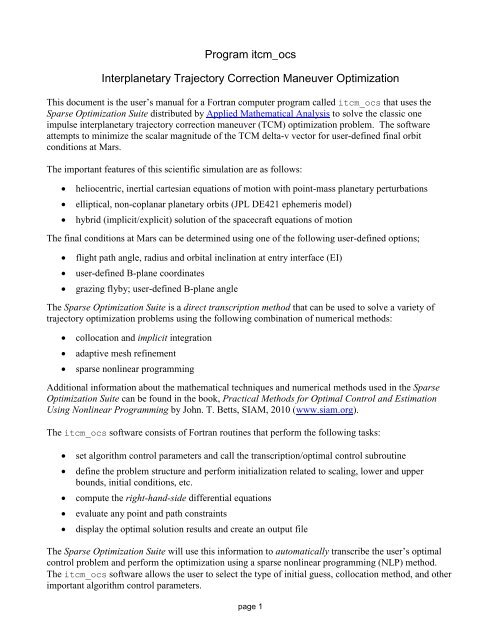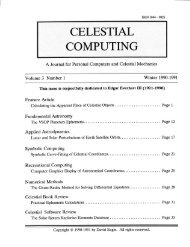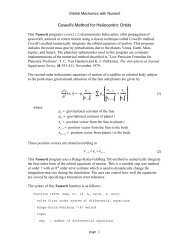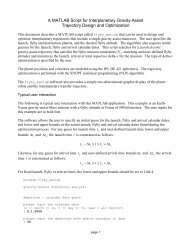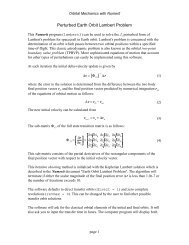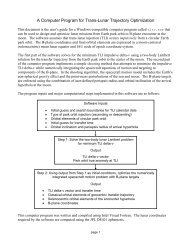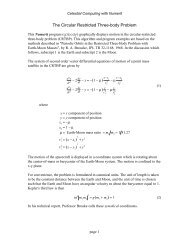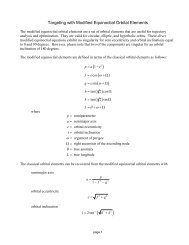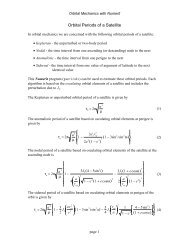PDF document - Orbital and Celestial Mechanics Website
PDF document - Orbital and Celestial Mechanics Website
PDF document - Orbital and Celestial Mechanics Website
You also want an ePaper? Increase the reach of your titles
YUMPU automatically turns print PDFs into web optimized ePapers that Google loves.
upper bound for TCM delta-v components (meters/second)+100.0The next integer input allows the user to specify the type of final orbit targeting at Mars.*****************************final orbit targeting options*****************************1 = user-defined flight path angle, radius <strong>and</strong> orbital inclination2 = user-defined B-plane coordinates3 = grazing flyby; user-defined b-plane angle----------------------------------------------1The next set of inputs defines the desired characteristics of the encounter hyperbola at Mars. Theorbital inclination <strong>and</strong> B-plane coordinates are defined with respect to the Mars mean equator <strong>and</strong> IAUnode of epoch coordinate system.***************************final Mars-centered targets***************************flight path angle (degrees)-2.0d0periapsis radius (kilometers)5000.0d0orbital inclination (degrees)60.0d0user-defined b dot r target (kilometers)-7889.908599155647607d0user-defined b dot t target (kilometers)4607.242716469171683d0user-defined b-plane angle (degrees)-60.0d0The next two inputs set the root-finding <strong>and</strong> truncation error tolerances used by the numerical methodsthat calculate the initial guess, predict the time of entrance into the Martian sphere-of-influence, <strong>and</strong> thetime of entry interface at Mars. Smaller values will improve the solution of the corresponding problemat the expense of longer computation times.**********************************************root-finding <strong>and</strong> integration algorithm control**********************************************root-finding tolerance1.0d-8RKF7(8) truncation error tolerance1.0d-12The next input is the user-defined value for the radius of the sphere-of-influence of Mars.-----------------------------------------------radius of Mars sphere-of-influence (kilometers)-----------------------------------------------150000.0page 4
This next input specifies the type of comma-delimited or comma-separated-variable (CSV) solution datafile to create. Option 1 will create a solution file at each collocation point or node determined by theSparse Optimization Suite software. Options 2 <strong>and</strong> 3 allow the user to specify either the number ofnodes (option 2) or time step size of the data file (option 3).*********************************************** type of comma-delimited solution data file ***********************************************1 = OCS-defined nodes2 = user-defined nodes3 = user-defined step size---------------------------1For options 2 or 3, this next input defines either the number of data points (option 2) or the time stepsize of the data output in the solution file (option 3).number of user-defined nodes or print step size in solution data file1The name of the solution data file is defined in this next line. Please consult Appendix B for adescription of the information written to this file.name of solution output filee2m_tcm.csvThe next series of program inputs are algorithm control options <strong>and</strong> parameters for the software. Thefirst input is an integer that specifies the type of collocation method to use during the solution process.For most simulations, the separated trapezoidal method is recommended.********************************* algorithm control parameters *********************************discretization/collocation method---------------------------------1 = trapezoidal2 = separated Hermite-Simpson3 = compressed Hermite-Simpson-------------------------------1The next input defines the relative error in the objective function.relative error in the objective function (performance index)1.0d-5The next input defines the relative error in the solution of the differential equations.relative error in the solution of the differential equations1.0d-7The next input is an integer that defines the maximum number of mesh refinement iterations.maximum number of mesh refinement iterations20The next input is an integer that defines the maximum number of function evaluations.maximum number of function evaluations50000page 5
The next input is an integer that defines the maximum number of algorithm iterations.maximum number of algorithm iterations10000The level of output from the NLP algorithm is controlled with the following integer input.***************************sparse NLP iteration output---------------------------1 = none2 = terse3 = st<strong>and</strong>ard4 = interpretive5 = diagnostic---------------2The level of output from the optimal control algorithm is controlled with the following integer input.Please note that option 4 will create lots of information.**********************optimal control output----------------------1 = none2 = terse3 = st<strong>and</strong>ard4 = interpretive-----------------1The level of output from the Sparse Optimization Suite differential equations algorithm is controlledwith the following integer input. Please note that option 5 will create lots of information.****************************differential equation output----------------------------1 = none2 = terse3 = st<strong>and</strong>ard4 = interpretive5 = diagnostic---------------1The level of output can be further controlled by the user with this final text input. This program optionsets the value of the SOCOUT character variable described in the Sparse Optimization Suite user’smanual. To ignore this special output control, input the simple character string no.*******************user-defined output-------------------input no to ignore------------------a0b0c0d0e0f0g0h0i0j2k0l0m0n0o0p0q0r0page 6
Optimal control solutionThe following is the program output created by the itcm_ocs simulation for this example. Please seeAppendix A for additional details about this information.program itcm_ocs================input data file ==> e2m_tcm.inuser-defined fpa, radius <strong>and</strong> orbital inclinationTCM delta-v vector <strong>and</strong> magnitude(heliocentric EME2000)----------------------delta-vx 2.86350904748275 meters/seconddelta-vy 19.7001824350835 meters/seconddelta-vz -2.66101349730156 meters/seconddeltav 20.0842690898477 meters/secondTCM delta-v inertial pointing angles(heliocentric EME2000)----------------------right ascension 81.7297238627486 degreesdeclination -7.61364380952683 degreesTCM delta-v orbit-plane pointing anglespitch -59.1104234734653 degreesyaw 265.879855271489 degreestime <strong>and</strong> conditions prior to TCM maneuver(heliocentric EME2000)----------------------calendar date June 8, 2003TDB time 18:20:44.077TDB Julian date 2452799.26439903sma (km) eccentricity inclination (deg) argper (deg)0.190725765750D+09 0.204056802425D+00 0.234926769446D+02 0.253488459798D+03raan (deg) true anomaly (deg) arglat (deg) period (hrs)0.463121032996D+00 0.394861259377D+01 0.257437072392D+03 0.126193097746D+05rx (km) ry (km) rz (km) rmag (km)-.319331575699D+08 -.136207676243D+09 -.590899587841D+08 0.151867971768D+09vx (kps) vy (kps) vz (kps) vmag (kps)0.316260605833D+02 -.655290816096D+01 -.295930903551D+01 0.324330976528D+02time <strong>and</strong> conditions after TCM maneuver(heliocentric EME2000)----------------------page 7
calendar date June 8, 2003TDB time 18:20:44.077TDB Julian date 2452799.26439903sma (km) eccentricity inclination (deg) argper (deg)0.190709071567D+09 0.203958745431D+00 0.234966353039D+02 0.253625947441D+03raan (deg) true anomaly (deg) arglat (deg) period (hrs)0.507601955901D+00 0.377033161794D+01 0.257396279059D+03 0.126176529628D+05rx (km) ry (km) rz (km) rmag (km)-.319331575699D+08 -.136207676243D+09 -.590899587841D+08 0.151867971768D+09vx (kps) vy (kps) vz (kps) vmag (kps)0.316289240924D+02 -.653320797852D+01 -.296197004901D+01 0.324321586131D+02time <strong>and</strong> conditions at Mars SOI(heliocentric EME2000)----------------------calendar date December 23, 2003TDB time 12:12:01.852TDB Julian date 2452997.00835477sma (km) eccentricity inclination (deg) argper (deg)0.187247875806D+09 0.200438765484D+00 0.234405112944D+02 0.252515275783D+03raan (deg) true anomaly (deg) arglat (deg) period (hrs)0.349747173989D+00 0.153380415508D+03 0.458956912906D+02 0.122757179103D+05rx (km) ry (km) rz (km) rmag (km)0.151506379502D+09 0.145182262180D+09 0.625457300247D+08 0.218961276544D+09vx (kps) vy (kps) vz (kps) vmag (kps)-.144142894220D+02 0.157622522163D+02 0.687219371498D+01 0.224376331400D+02time <strong>and</strong> conditions at Mars SOI(Mars-centered mean equator <strong>and</strong> IAU node of epoch)--------------------------------------------------calendar date December 23, 2003TDB time 12:12:01.852TDB Julian date 2452997.00835477sma (km) eccentricity inclination (deg) argper (deg)-.584702528676D+04 0.185439805366D+01 0.599912397782D+02 0.113996849370D+03raan (deg) true anomaly (deg) arglat (deg)0.105662975108D+03 0.240791169623D+03 0.354788018992D+03rx (km) ry (km) rz (km) rmag (km)-.337675013536D+05 0.145672670795D+06 -.117995275907D+05 0.150000000052D+06vx (kps) vy (kps) vz (kps) vmag (kps)0.548429658956D+00 -.273194181989D+01 0.362737401110D+00 0.280995722747D+01page 8
B-plane coordinates at Mars SOI(Mars-centered mean equator <strong>and</strong> IAU node of epoch)--------------------------------------------------b-magnitude 9131.08457768479 kilometersb dot r -7884.33839198771 kilometersb dot t 4605.85645515161 kilometerstheta 300.292529567016 degreesv-infinity 2706.43946990651 meters/secondr-periapsis 4995.68702468775 kilometersdecl-asymptote 7.47149058794170 degreesrasc-asymptote 281.318997229982 degreesflight path angle -86.6387448063388 degreestime <strong>and</strong> conditions at Mars entry interface(Mars-centered mean equator <strong>and</strong> IAU node of epoch)--------------------------------------------------calendar date December 24, 2003TDB time 02:07:38.158TDB Julian date 2452997.58863608sma (km) eccentricity inclination (deg) argper (deg)-.585291050016D+04 0.185347485194D+01 0.600000000635D+02 0.113993614818D+03raan (deg) true anomaly (deg) arglat (deg)0.105636717750D+03 0.356921101065D+03 0.110914715883D+03rx (km) ry (km) rz (km) rmag (km)-.176775951944D+04 -.234827585865D+04 0.404482714855D+04 0.499999998885D+04vx (kps) vy (kps) vz (kps) vmag (kps)0.215455686466D+01 -.412635750164D+01 -.166729072802D+01 0.494457277084D+01B-plane coordinates at Mars entry interface(Mars-centered mean equator <strong>and</strong> equinox of date)------------------------------------------------b-magnitude 9133.85835280744 kilometersb dot r -7887.32724447201 kilometersb dot t 4606.23895903804 kilometerstheta 300.285144200537 degreesv-infinity 2705.07843937188 meters/secondr-periapsis 4995.31192252423 kilometersdecl-asymptote 7.49072940722751 degreesrasc-asymptote 281.282944565443 degreesflight path angle -2.00000000002416 degreestime <strong>and</strong> conditions of Mars at entry interface(heliocentric EME2000)----------------------calendar date December 24, 2003TDB time 02:07:38.158TDB Julian date 2452997.58863608page 9
sma (au) eccentricity inclination (deg) argper (deg)0.152368043785D+01 0.935420837075D-01 0.246772248956D+02 0.332979294518D+03raan (deg) true anomaly (deg) arglat (deg) period (days)0.337165819738D+01 0.704475973849D+02 0.434268919026D+02 0.686972361210D+03rx (km) ry (km) rz (km) rmag (km)0.150787801633D+09 0.145972773409D+09 0.628789377224D+08 0.219086221628D+09vx (kps) vy (kps) vz (kps) vmag (kps)-.166518297346D+02 0.168787718592D+02 0.819178961924D+01 0.250854896335D+02transfer time 198.324237048160 daysThe itcm_ocs software will create two comma-separated-variable (csv) output files. The first file hasthe name specified by the user <strong>and</strong> contains the heliocentric state vectors of the spacecraft <strong>and</strong> the Earth<strong>and</strong> Mars. The second file is called soiorb.csv <strong>and</strong> contains the Mars-centered state vector at thesphere-of-influence.The following is the soiorb.csv data for this example.0.2452997008354774D+07, -.1768303167878195D+04, -.2351415357895747D+04,0.4044355626544280D+04, 0.2155870496202545D+01, -.4126374034966497D+01, -.1667933926494574D+01,The itcm_ocs software package also includes a MATLAB script called mplot.m that can be used tocreate trajectory graphic displays using the soiorb.csv data file. The interactive graphic features ofMATLAB allow the user to rotate <strong>and</strong> zoom the displays. These capabilities allow the user tointeractively find the best viewpoint as well as verify basic orbital geometry of the hyperbolic encountertrajectory at Mars.The following plot is a “zoomed” view of the encounter trajectory at Mars. This display is labeled witha Mars centered, inertial coordinate system. The x-axis of this areocentric system is red, the y-axisgreen <strong>and</strong> the z-axis blue. The small red dot is the location of the entry interface.page 10
Verification of the optimal control solutionThe optimal control solution determined by the Sparse Optimization Suite software can be verified bynumerically integrating the orbital equations of motion with the optimal control solution <strong>and</strong> the initialheliocentric conditions provided by the user. This is equivalent to solving an initial value problem (IVP)that uses the optimal impulsive thrust vector solution.This part of the itcm_ocs computer program uses a Runge-Kutta-Fehlberg 7(8) variable step sizemethod to integrate the orbital equations of motion. The following is a display of the final solutioncomputed using this explicit numerical integration method.========================================verification of optimal control solution========================================time <strong>and</strong> conditions after TCM maneuver(heliocentric EME2000)----------------------calendar date June 8, 2003TDB time 18:20:44.077TDB Julian date 2452799.26439903sma (km) eccentricity inclination (deg) argper (deg)0.190709071567D+09 0.203958745431D+00 0.234966353039D+02 0.253625947441D+03raan (deg) true anomaly (deg) arglat (deg) period (hrs)0.507601955901D+00 0.377033161794D+01 0.257396279059D+03 0.126176529628D+05rx (km) ry (km) rz (km) rmag (km)-.319331575699D+08 -.136207676243D+09 -.590899587841D+08 0.151867971768D+09vx (kps) vy (kps) vz (kps) vmag (kps)0.316289240924D+02 -.653320797852D+01 -.296197004901D+01 0.324321586131D+02time <strong>and</strong> conditions at Mars sphere-of-influence(Mars-centered mean equator <strong>and</strong> IAU node of epoch)--------------------------------------------------calendar date December 23, 2003TDB time 12:12:01.852TDB Julian date 2452997.00835477sma (km) eccentricity inclination (deg) argper (deg)-.584702575071D+04 0.185441779440D+01 0.599953756038D+02 0.113996819994D+03raan (deg) true anomaly (deg) arglat (deg)0.105662253432D+03 0.240791638892D+03 0.354788458886D+03rx (km) ry (km) rz (km) rmag (km)-.337667963805D+05 0.145671644140D+06 -.117989317052D+05 0.149998797440D+06vx (kps) vy (kps) vz (kps) vmag (kps)0.548429795002D+00 -.273194252894D+01 0.362737364915D+00 0.280995793872D+01page 11
B-plane coordinates at Mars sphere-of-influence(Mars-centered mean equator <strong>and</strong> IAU node of epoch)--------------------------------------------------b-magnitude 9131.22236299615 kilometersb dot r -7884.79362085750 kilometersb dot t 4605.35030143918 kilometerstheta 300.288346415312 degreesv-infinity 2706.43936253276 meters/secondr-periapsis 4995.80284573990 kilometersdecl-asymptote 7.47149194895923 degreesrasc-asymptote 281.319000130777 degreesflight path angle -86.6386680328833 degreestime <strong>and</strong> conditions at Mars entry interface(Mars-centered mean equator <strong>and</strong> IAU node of epoch)--------------------------------------------------calendar date December 24, 2003TDB time 02:07:38.158TDB Julian date 2452997.58863608sma (km) eccentricity inclination (deg) argper (deg)-.584304937602D+04 0.185515028038D+01 0.599817961400D+02 0.113992445290D+03raan (deg) true anomaly (deg) arglat (deg)0.105639013468D+03 0.356950775849D+03 0.110943221140D+03rx (km) ry (km) rz (km) rmag (km)-.176830316788D+04 -.235141535790D+04 0.404435562654D+04 0.500128610588D+04vx (kps) vy (kps) vz (kps) vmag (kps)0.215587049620D+01 -.412637403497D+01 -.166793392649D+01 0.494537600754D+01B-plane coordinates at Mars entry interface(Mars-centered mean equator <strong>and</strong> IAU node of epoch)--------------------------------------------------b-magnitude 9130.09430947819 kilometersb dot r -7882.77552850412 kilometersb dot t 4606.56836128398 kilometerstheta 300.301334295321 degreesv-infinity 2707.36011349352 meters/secondr-periapsis 4996.68531218008 kilometersdecl-asymptote 7.46173444525707 degreesrasc-asymptote 281.299129226053 degreesflight path angle -1.98134902376417 degreestime <strong>and</strong> conditions of Mars at entry interface(heliocentric EME2000)----------------------calendar date December 24, 2003TDB time 02:07:38.158TDB Julian date 2452997.58863608page 12
sma (au) eccentricity inclination (deg) argper (deg)0.152368043785D+01 0.935420837075D-01 0.246772248956D+02 0.332979294518D+03raan (deg) true anomaly (deg) arglat (deg) period (days)0.337165819738D+01 0.704475973849D+02 0.434268919026D+02 0.686972361210D+03rx (km) ry (km) rz (km) rmag (km)0.150787801633D+09 0.145972773409D+09 0.628789377224D+08 0.219086221628D+09vx (kps) vy (kps) vz (kps) vmag (kps)-.166518297346D+02 0.168787718592D+02 0.819178961924D+01 0.250854896335D+02transfer time 198.324237048160 daysProblem setupThis section provides additional details about the software implementation. For good scaling during theoptimization, the time unit used in all heliocentric calculations is days, position is expressed inastronomical units, <strong>and</strong> the velocity <strong>and</strong> TCM delta-v unit is astronomical units per day. The areocentricor Mars-centered motion is modeled using seconds, kilometers <strong>and</strong> kilometers per second.During the solution of this optimal control problem, the itcm_ocs software models the heliocentricmotion implicitly using collocation <strong>and</strong> the Mars-centered orbital motion explicitly using numericalintegration of the equations of motion.(1) Performance index – minimize TCM delta-vThe objective function or performance index J for this simulation is the scalar magnitude of theimpulsive TCM delta-v vector. For this classic trajectory optimization problem, this index is simplyJ VThe value of the maxmin indicator in tells the software whether the user is minimizing or maximizingthe performance index.The components of the impulsive TCM delta-v are the optimization parameters used by the SparseOptimization Suite to solve this trajectory problem.(2) Point functions – position <strong>and</strong> velocity vector “matching” at the TCMThe optimal solution must satisfy the following state vector boundary conditions (equality constraints) atthe initial time defined by the user:r t rt 0 s / c TCM s / c TCMt t tv v v 0s / c TCM s / c TCM TCMwhere rs/c<strong>and</strong> vs/care the heliocentric position <strong>and</strong> velocity vectors of the spacecraft prior to the TCMmaneuver time t TCM, rs/c<strong>and</strong> vs/care the heliocentric position <strong>and</strong> velocity vectors of the spacecraftafter the TCM delta-v is applied, <strong>and</strong> v is the impulsive TCM delta-v vector.page 13
(3) Point functions – SOI distance <strong>and</strong> final orbit targets at encounterAt the user-defined sphere-of-influence of Mars, the point function enforced by the software is given byrSOI pr 0SOIuwhererSOI pis the SOI value predicted by the software <strong>and</strong>rSOI uis the SOI value defined by the user.Targeting to a Mars-centered flight path angle, periapsis radius <strong>and</strong> orbital inclinationFor user-defined flight path angle, periapsis radius <strong>and</strong> orbital inclination targets at the Martian entryinterface, the following point functions or equality constraints are enforced uruprp00cosihˆ0uwhere u, r u<strong>and</strong> i uare the user-defined entry interface flight path angle, periapsis radius <strong>and</strong> Marscentered orbital inclination of the encounter hyperbola, respectively. In these equations, p<strong>and</strong> r prepresent the flight path angle <strong>and</strong> periapsis radius predicted by the software. Note that h ˆzis the z-component of the predicted unit angular momentum vector. These orbital characteristics are determinedfrom the spacecraft’s state vector at the entry interface relative to Mars.Targeting to a Mars-centered grazing flybyThe general expression for the periapsis radius of an encounter hyperbola at Mars is given bywhere the normalized quantities arerp21 vz2 41 bv1r normalized periapsis radius r rp p mb normalized b-plane magnitude b rv normalized v-infinity speed v vvrlc m mm radius of Mars gravitational constant of Marsm local circular speed at Mars For a grazing flyby, rp 1 <strong>and</strong> the normalized B-plane distance is equal tolcrmpage 14
2 1v2The required B-plane equality constraints are computed fromBTbBRbcossinwhere is the user-defined B-plane angle of the grazing trajectory. Please note that the B-plane angleis measured positive clockwise from the T axis of the B-plane coordinate system. The two equalityconstraints for this program option are simply the difference between the predicted <strong>and</strong> required BT<strong>and</strong> BR components.Targeting to user-defined B-plane coordinatesFor this program option, the two equality constraints are simply the difference between the predicted <strong>and</strong>user-defined BT <strong>and</strong> BR components. The B-plane constraints for this <strong>and</strong> the previous option arescaled by dividing by the equatorial radius of Mars.Creating an initial guessAn initial guess for the heliocentric transfer trajectory is created by numerically integrating theheliocentric equations of motion using the user’s input for the initial time <strong>and</strong> state of the spacecraft <strong>and</strong>the initial guess for the TCM delta-v vector. The position <strong>and</strong> velocity vectors at each grid point aredetermined by setting the initial guess option INIT(1) = 6 with INIT(2) = 2 which instructs thesoftware to use the built-in Dorm<strong>and</strong>-Prince solution method.The final time for the heliocentric phase is estimated by searching for the instance at which thespacecraft reaches the user-defined sphere-of-influence at Mars. The numerical technique used toestimate the SOI consists of Brent’s one-dimensional root-finder imbedded within a Runge-Kutta-Fehlberg 7(8) integrator. If an initial guess for the TCM maneuver is not available, a larger SOI radiusshould be used.Technical DiscussionThis section provides additional details about the numerical algorithms used in this computer program.The numerical methods discussed here include; propagating the spacecraft’s heliocentric trajectory, B-plane coordinates <strong>and</strong> the Mars-centered coordinate transformation.The spacecraft’s orbital motion is modeled with respect to the Earth mean equator <strong>and</strong> equinox of J2000(EME2000) coordinate system. The following figure illustrates the geometry of the EME2000coordinate system. The origin of this Earth-centered-inertial (ECI) inertial coordinate system is thegeocenter <strong>and</strong> the fundamental plane is the Earth’s mean equator. The z-axis of this system is normal tothe Earth’s mean equator at epoch J2000, the x-axis is parallel to the vernal equinox of the Earth’s meanorbit at epoch J2000, <strong>and</strong> the y-axis completes the right-h<strong>and</strong>ed coordinate system. The epoch J2000 isthe Julian Date 2451545.0 which corresponds to January 1, 2000, 12 hours Terrestrial Time (TT).page 15
Heliocentric equations of motionFigure 1. Earth mean equator <strong>and</strong> equinox of J2000 coordinate systemThe general, second-order vector equation of motion subject to point-mass perturbations such as theMoon or planets is given byn j jr d js 3 3j1djs jIn this equation, sjis the vector from the primary body to the secondary body j,jis the gravitationalconstant of the secondary body <strong>and</strong> djr s j, where r is the position vector of the spacecraft relativeto the primary body.To avoid numerical problems, use is made of Richard Battin’sFq function given bywhereF qkq2 33qkqk qk 3 11qk kT 2 r r sTsskkkThe third-body acceleration can now be expressed asnr Fqkkdr s k1k3kpage 16
The first-order system of equations required by the software can be created from the second-ordersystem by the method of order reduction. With the following definitions,y r y r y r1 x 2 y 3 zy v y v y v4 x 5 y 6 zwhere vx, vy,vzare the velocity vector components of the spacecraft, the first-order system ofdifferential equations is given byy v y v y v1 x 2 y 3 zrrry a y a y ar r rxyz4 s 3 x 5 s 3 y 6 s 3 zIn these equations, is the gravitational constant of the sun, <strong>and</strong> a , a <strong>and</strong> a are the x, y <strong>and</strong> zsx y zgravitational contributions of the planets. The equations described here are coded in the right-h<strong>and</strong>-sidesubroutine required by the software.In this computer program the heliocentric coordinates of the planets are based on the JPL DevelopmentEphemeris DE421. These coordinates are provided in the Earth mean equator <strong>and</strong> equinox of J2000coordinate system (EME2000).Time from the Martian SOI to entry interfaceThe elapsed time from the Martian SOI until the entry interface is determined by an algorithm thatincludes a one-dimensional root-finder embedded with a Runge-Kutta-Fehlberg 7(8) numericalintegration method. This technique searches for the time at which the predicted Mars-centered flightpath angle of the spacecraft <strong>and</strong> the user-defined entry interface flight path angle is zero. This missionconstraint is computed as follows1pusin rv u 0 rvwhere r <strong>and</strong> v are the Mars-centered position <strong>and</strong> velocity vectors, respectively.The RKF78 method numerically solves the following system of six first-order differential equationsy v y y v y y v y1 x 4 2 y 5 2 z 6yyy J r ar 2 r r 2 2rx 3 2 eq 5rz4 1 13 2 2r J r r ar 2 r r 2 2y 3 2 eq 5z5 1 13 2 2 J r ar 2 r r 2 2rz 3 2 eq 5rz6 1 33 2 2sxsyszpage 17
In these equations, <strong>and</strong> r eqare the gravitational constant <strong>and</strong> equatorial radius of Mars, respectively,J2is the non-dimensional oblateness gravity coefficient of Mars, <strong>and</strong> the Mars-centered accelerationvector of the sun is represented by the components as, as<strong>and</strong> as z.The B-planeThe derivation of B-plane coordinates is described in the classic JPL reports, “A Method of DescribingMiss Distances for Lunar <strong>and</strong> Interplanetary Trajectories” <strong>and</strong> “Some <strong>Orbital</strong> Elements Useful in SpaceTrajectory Calculations”, both by William Kizner. The following diagram illustrates the fundamentalgeometry of the B-plane coordinate system.xyThe arrival asymptote unit vector Ŝ is given by coscosˆ S cossin sin where <strong>and</strong> are the declination <strong>and</strong> right ascension of the asymptote of the incoming hyperbola.The following computational steps summarize the calculation of the predicted B-plane vector from aMars-centered position vector r <strong>and</strong> velocity vector v at the time of entry interface to Mars.angular momentum vectorh r vpage 18
adius ratesemiparametersemimajor axisorbital eccentricitytrue anomalyr r v rp 2hra 2rv 2 e 1p acosp r sinr hereB-plane magnitudeB p afundamental vectorsr rz ˆ v rhpˆ cos rˆ sin zˆqˆ sin rˆ cosz ˆS vectorB vectorT vectorR vectorS a bpˆ2 2 2 2a b a bq ˆB 2b abpˆ2 2 2 2a b a bq ˆT 2 2y x2 2x yS , S,0 TS SR S T S T , S T , S T S Tz y z x x y y xTpage 19
Geocentric-to-areocentric coordinate transformationThis section describes the transformation of coordinates between the Earth mean equator <strong>and</strong> equinox ofJ2000 <strong>and</strong> areocentric mean equator <strong>and</strong> IAU node of epoch coordinate systems. This transformation isused to compute the B-plane coordinates at encounter.A unit vector in the direction of the pole of Mars can be determined fromcospcospp ˆMars sinp cosp sinp The IAU 2000 right ascension <strong>and</strong> declination of the pole of Mars in the EME2000 coordinate systemare given by the following expressions 317.68143 0.1061Tpp52.88650 0.0609Twhere T is the time in Julian centuries given by T JDDate.The unit vector in the direction of the IAU-defined x-axis is computed fromˆ 2451545.0 / 36525 <strong>and</strong> JD is the TDB Julianˆxˆ pJ 2000pMarswhere ˆ p 0 01 Tis unit vector in the direction of the pole of the J2000 coordinate system.J 2000The unit vector in the y-axis direction of this coordinate system isyˆpˆxˆFinally, the components of the matrix that transforms coordinates from the EME2000 system to theMars-centered mean equator <strong>and</strong> IAU node of epoch system are as follows:Impulsive maneuver modelingM Marsxˆyˆpˆ MarsIn the itcm_ocs computer program, the components of the inertial unit thrust vector can be defined interms of the right ascension <strong>and</strong> the declination angle as follows:page 20
u cos cos u sin cos u sinTECI Tx ECI Ty ECI zThe right ascension <strong>and</strong> declination angles can be determined from the components of the ECI unitthrust vector according touT u ECI T uy ECI Tx ECI z tan , sin1 1where the inverse tangent calculation is a four quadrant operation.The components of the unit thrust vector can also be defined in terms of the in-plane pitch angle <strong>and</strong>the out-of-plane yaw angle as follows:u sin u cos cos u cos sinTr Tt TnFinally, the pitch <strong>and</strong> yaw angles can be determined from the components of the RTN unit thrust vectoraccording to1 1 sin u tan u , u T T T r n tThe pitch angle is positive above the “local horizontal” <strong>and</strong> the yaw angle is positive in the direction ofthe angular momentum vector.The relationship between a unit thrust vector in the ECI coordinate system u ˆT ECI<strong>and</strong> the correspondingunit thrust vector in the radial-tangential-normal (RTN) system u ˆT RTNis given bywhereThis relationship can also be expressed asuˆ ˆ ˆ ˆ ˆECI i i i uT r t n TRTNˆ r ˆ r vˆˆ ˆ ˆ ˆr v rir r in h it in irr r v r v rrˆˆ ˆ ˆxh r h xx uˆ Quˆ rˆhˆrˆhˆuˆy ˆ ˆ ˆ ˆrzh r hzz TECI TRTN y y TRTNIn these equations, r is the inertial position vector <strong>and</strong> v is the inertial velocity vector of the spacecraft.page 21
Algorithm resources“Update to Mars Coordinate Frame Definitions”, R. A. Mase, JPL IOM 312.B/015-99, 15 July 1999.“JPL Planetary Ephemeris DE421”, E. M. St<strong>and</strong>ish, JPL IOM 312.N-03-009, 24 April 2003.“Report of the IAU/IAG Working Group on Cartographic Coordinates <strong>and</strong> Rotational Elements of thePlanets <strong>and</strong> Satellites: 2000”, <strong>Celestial</strong> <strong>Mechanics</strong> <strong>and</strong> Dynamical Astronomy, 82: 83-110, 2002.“IERS Conventions (2003)”, IERS Technical Note 32, November 2003.“Planetary Constants <strong>and</strong> Models”, R. Vaughan, JPL D-12947, December 1995.“Preliminary Mars Planetary Constants <strong>and</strong> Models for Mars Sample Return”, D. Lyons, JPL IOM312/99.DTL-1, 20 January 1999.“Interplanetary Mission Design H<strong>and</strong>book, Volume 1, Part 2”, JPL Publication 82-43, September 15,1983.“Interplanetary Mission Analysis <strong>and</strong> Design”, Stephen Kemble, Praxis Publishing, 2006.page 22
APPENDIX AContents of the Simulation Summary <strong>and</strong> CSV FilesThis appendix is a brief summary of the information contained in the simulation summary screendisplays <strong>and</strong> the CSV data files produced by the itcm_ocs software.The simulation summary screen display contains the following information:calendar date = calendar date of trajectory eventTDB time = Barycentric Dynamical Time time of trajectory eventTDB julian date = Barycentric Dynamical Time julian date of trajectory eventsma (km) = semimajor axis in kilometers or astronomical unitseccentricity = orbital eccentricity (non-dimensional)inclination (deg) = orbital inclination in degreesargper (deg) = argument of perigee in degreesraan (deg) = right ascension of the ascending node in degreestrue anomaly (deg) = true anomaly in degreesarglat (deg) = argument of latitude in degrees. The argument of latitude is the sum oftrue anomaly <strong>and</strong> argument of perigee.period (days) = orbital period in hours or daysdelta-vx = x-component of the impulsive TCM velocity vector in meters/seconddelta-vy = y-component of the impulsive TCM velocity vector in meters/seconddelta-vz = z-component of the impulsive TCM velocity vector in meters/seconddeltav = scalar magnitude of the impulsive TCM delta-v in meters/secondstransfer time = elapsed time from TCM to entry interface in daysThe comma-separated-variable disk file is created by the odeprt subroutine <strong>and</strong> contains the followinginformation:time (days) = simulation time since launch in daysrs2sc-x (au) = x-component of spacecraft position vector in astronomical unitsrs2sc-y (au) = y-component of spacecraft position vector in astronomical unitsrs2sc-z (au) = z-component of spacecraft position vector in astronomical unitsrs2sc-mag (au) = heliocentric radius magnitude of spacecraft in astronomical unitsvs2sc-x (km/sec) = x-component of spacecraft velocity vector in kilometers per secondvs2sc-y (km/sec) = y-component of spacecraft velocity vector in kilometers per secondvs2sc-z (km/sec) = z-component of spacecraft velocity vector in kilometers per secondvs2sc-mag (km/sec) = heliocentric velocity of spacecraft in kilometers per secondpage 23
s2e-x (au) = x-component of Earth position vector in astronomical unitsrs2e-y (au) = y-component of Earth position vector in astronomical unitsrs2e-z (au) = z-component of Earth position vector in astronomical unitsrs2e-mag (au) = heliocentric radius magnitude of Earth in astronomical unitsrs2m-x (au) = x-component of Mars position vector in astronomical unitsrs2m-y (au) = y-component of Mars position vector in astronomical unitsrs2m-z (au) = z-component of Mars position vector in astronomical unitsrs2m-mag (au) = heliocentric radius magnitude of Mars in astronomical unitssma (au) = transfer orbit semimajor axis in astronomical unitseccentricity = transfer orbit orbital eccentricity (non-dimensional)inclination (deg) = transfer orbit orbital inclination in degreesargper (deg) = transfer orbit argument of perigee in degreesraan (deg) = transfer orbit right ascension of the ascending node in degreestrue anomaly (deg) = transfer orbit true anomaly in degreesThe heliocentric coordinates of the spacecraft are with respect to the Earth mean equator <strong>and</strong> equinox ofJ2000 coordinate system.page 24
APPENDIX BAdditional Program ExamplesThis appendix provides typical output from the itcm_ocs computer program for the two other types ofuser-defined final orbit targeting options.The first example illustrates the solution for the “user-defined B-plane coordinates” program option.program itcm_ocs================input data file ==> e2m_tcm.inuser-defined B-plane coordinatesTCM delta-v vector <strong>and</strong> magnitude(heliocentric EME2000)----------------------delta-vx 2.86319939603731 meters/seconddelta-vy 19.6995282017581 meters/seconddelta-vz -2.66239935347611 meters/seconddeltav 20.0837668894737 meters/secondTCM delta-v inertial pointing angles(heliocentric EME2000)----------------------right ascension 81.7303349840741 degreesdeclination -7.61782413127838 degreesTCM delta-v orbit-plane pointing anglespitch -59.1061997378721 degreesyaw 265.879945402545 degreestime <strong>and</strong> conditions prior to TCM maneuver(heliocentric EME2000)----------------------calendar date June 8, 2003TDB time 18:20:44.077TDB Julian date 2452799.26439903sma (km) eccentricity inclination (deg) argper (deg)0.190725765750D+09 0.204056802425D+00 0.234926769446D+02 0.253488459798D+03raan (deg) true anomaly (deg) arglat (deg) period (hrs)0.463121032996D+00 0.394861259377D+01 0.257437072392D+03 0.126193097746D+05rx (km) ry (km) rz (km) rmag (km)-.319331575699D+08 -.136207676243D+09 -.590899587841D+08 0.151867971768D+09vx (kps) vy (kps) vz (kps) vmag (kps)0.316260605833D+02 -.655290816096D+01 -.295930903551D+01 0.324330976528D+02page 25
time <strong>and</strong> conditions after TCM maneuver(heliocentric EME2000)----------------------calendar date June 8, 2003TDB time 18:20:44.077TDB Julian date 2452799.26439903sma (km) eccentricity inclination (deg) argper (deg)0.190709070791D+09 0.203958744122D+00 0.234966356937D+02 0.253625930969D+03raan (deg) true anomaly (deg) arglat (deg) period (hrs)0.507606328913D+00 0.377034407992D+01 0.257396275048D+03 0.126176528859D+05rx (km) ry (km) rz (km) rmag (km)-.319331575699D+08 -.136207676243D+09 -.590899587841D+08 0.151867971768D+09vx (kps) vy (kps) vz (kps) vmag (kps)0.316289237827D+02 -.653320863275D+01 -.296197143486D+01 0.324321585694D+02time <strong>and</strong> conditions at Mars SOI(heliocentric EME2000)----------------------calendar date December 23, 2003TDB time 12:11:53.222TDB Julian date 2452997.00825489sma (km) eccentricity inclination (deg) argper (deg)0.187247879371D+09 0.200438746485D+00 0.234405099417D+02 0.252515267845D+03raan (deg) true anomaly (deg) arglat (deg) period (hrs)0.349747285864D+00 0.153380366636D+03 0.458956344806D+02 0.122757182608D+05rx (km) ry (km) rz (km) rmag (km)0.151506522761D+09 0.145182113640D+09 0.625456610679D+08 0.218961257483D+09vx (kps) vy (kps) vz (kps) vmag (kps)-.144142713323D+02 0.157622694803D+02 0.687220071981D+01 0.224376357922D+02time <strong>and</strong> conditions at Mars SOI(Mars-centered mean equator <strong>and</strong> IAU node of epoch)--------------------------------------------------calendar date December 23, 2003TDB time 12:11:53.222TDB Julian date 2452997.00825489sma (km) eccentricity inclination (deg) argper (deg)-.584702316280D+04 0.185483277292D+01 0.599934925094D+02 0.113988421462D+03raan (deg) true anomaly (deg) arglat (deg)0.105662627673D+03 0.240800899993D+03 0.354789321455D+03page 26
x (km) ry (km) rz (km) rmag (km)-.337687834884D+05 0.145672590091D+06 -.117968549216D+05 0.150000000094D+06vx (kps) vy (kps) vz (kps) vmag (kps)0.548431763855D+00 -.273194184951D+01 0.362737662989D+00 0.280995770090D+01B-plane coordinates at Mars SOI(Mars-centered mean equator <strong>and</strong> IAU node of epoch)--------------------------------------------------b-magnitude 9134.09939400168 kilometersb dot r -7887.12464736178 kilometersb dot t 4607.06376518497 kilometerstheta 300.290252792670 degreesv-infinity 2706.43996147019 meters/secondr-periapsis 4998.22702360868 kilometersdecl-asymptote 7.47151398172520 degreesrasc-asymptote 281.319031124716 degreesflight path angle -86.6376336996082 degreestime <strong>and</strong> conditions at Mars entry interface(Mars-centered mean equator <strong>and</strong> IAU node of epoch)--------------------------------------------------calendar date December 24, 2003TDB time 02:08:24.228TDB Julian date 2452997.58916931sma (km) eccentricity inclination (deg) argper (deg)-.585238914353D+04 0.185398544607D+01 0.600026998845D+02 0.113983698032D+03raan (deg) true anomaly (deg) arglat (deg)0.105635154805D+03 0.943988629458D-11 0.113983698032D+03rx (km) ry (km) rz (km) rmag (km)-.165099600309D+04 -.257162985432D+04 0.395467928201D+04 0.499785515330D+04vx (kps) vy (kps) vz (kps) vmag (kps)0.218557952117D+01 -.408034991477D+01 -.174091654773D+01 0.494538205769D+01B-plane coordinates at Mars entry interface(Mars-centered mean equator <strong>and</strong> equinox of date)------------------------------------------------b-magnitude 9136.59360010819 kilometersb dot r -7889.90857959034 kilometersb dot t 4607.24269159383 kilometerstheta 300.282416133723 degreesv-infinity 2705.19892684709 meters/secondr-periapsis 4997.85515329978 kilometersdecl-asymptote 7.49076682019675 degreesrasc-asymptote 281.281834267215 degreesflight path angle6.118383566213922E-012 degreestime <strong>and</strong> conditions of Mars at entry interface(heliocentric EME2000)----------------------page 27
calendar date December 24, 2003TDB time 02:08:24.228TDB Julian date 2452997.58916931sma (au) eccentricity inclination (deg) argper (deg)0.152368043758D+01 0.935420835209D-01 0.246772248956D+02 0.332979294463D+03raan (deg) true anomaly (deg) arglat (deg) period (days)0.337165819751D+01 0.704478985850D+02 0.434271930482D+02 0.686972361028D+03rx (km) ry (km) rz (km) rmag (km)0.150787034465D+09 0.145973551028D+09 0.628793151252D+08 0.219086320051D+09vx (kps) vy (kps) vz (kps) vmag (kps)-.166519174072D+02 0.168786869834D+02 0.819175305828D+01 0.250854787833D+02transfer time 198.324770276900 days========================================verification of optimal control solution========================================time <strong>and</strong> conditions after TCM maneuver(heliocentric EME2000)----------------------calendar date June 8, 2003TDB time 18:20:44.077TDB Julian date 2452799.26439903sma (km) eccentricity inclination (deg) argper (deg)0.190709070791D+09 0.203958744122D+00 0.234966356937D+02 0.253625930969D+03raan (deg) true anomaly (deg) arglat (deg) period (hrs)0.507606328913D+00 0.377034407992D+01 0.257396275048D+03 0.126176528859D+05rx (km) ry (km) rz (km) rmag (km)-.319331575699D+08 -.136207676243D+09 -.590899587841D+08 0.151867971768D+09vx (kps) vy (kps) vz (kps) vmag (kps)0.316289237827D+02 -.653320863275D+01 -.296197143486D+01 0.324321585694D+02time <strong>and</strong> conditions at Mars sphere-of-influence(Mars-centered mean equator <strong>and</strong> IAU node of epoch)--------------------------------------------------calendar date December 23, 2003TDB time 12:11:53.222TDB Julian date 2452997.00825489sma (km) eccentricity inclination (deg) argper (deg)-.584702362802D+04 0.185485195809D+01 0.599976005752D+02 0.113988400827D+03raan (deg) true anomaly (deg) arglat (deg)page 28
0.105661910874D+03 0.240801356489D+03 0.354789757316D+03rx (km) ry (km) rz (km) rmag (km)-.337680811049D+05 0.145671568048D+06 -.117962651191D+05 0.149998803028D+06vx (kps) vy (kps) vz (kps) vmag (kps)0.548431898745D+00 -.273194255448D+01 0.362737627915D+00 0.280995840810D+01B-plane coordinates at Mars sphere-of-influence(Mars-centered mean equator <strong>and</strong> IAU node of epoch)--------------------------------------------------b-magnitude 9134.23331130423 kilometersb dot r -7887.57436946527 kilometersb dot t 4606.55931813478 kilometerstheta 300.286097720332 degreesv-infinity 2706.43985380146 meters/secondr-periapsis 4998.33959743101 kilometersdecl-asymptote 7.47151533485788 degreesrasc-asymptote 281.319034008987 degreesflight path angle -86.6375584629909 degreestime <strong>and</strong> conditions at Mars entry interface(Mars-centered mean equator <strong>and</strong> IAU node of epoch)--------------------------------------------------calendar date December 24, 2003TDB time 02:08:24.228TDB Julian date 2452997.58916931sma (km) eccentricity inclination (deg) argper (deg)-.584252256897D+04 0.185566113250D+01 0.599842372070D+02 0.113985732959D+03raan (deg) true anomaly (deg) arglat (deg)0.105638125635D+03 0.257396943962D-01 0.114011472653D+03rx (km) ry (km) rz (km) rmag (km)-.165146923266D+04 -.257476031520D+04 0.395416961698D+04 0.499921980583D+04vx (kps) vy (kps) vz (kps) vmag (kps)0.218698975054D+01 -.408023503281D+01 -.174162041257D+01 0.494615848447D+01B-plane coordinates at Mars entry interface(Mars-centered mean equator <strong>and</strong> IAU node of epoch)--------------------------------------------------b-magnitude 9132.81449743411 kilometersb dot r -7885.33948200035 kilometersb dot t 4607.57223471854 kilometerstheta 300.298656032703 degreesv-infinity 2707.48216901316 meters/secondr-periapsis 4999.21947802138 kilometersdecl-asymptote 7.45899949361513 degreesrasc-asymptote 281.300280791164 degreesflight path angle1.672612694781776E-002 degreestime <strong>and</strong> conditions of Mars at entry interface(heliocentric EME2000)page 29
----------------------calendar date December 24, 2003TDB time 02:08:24.228TDB Julian date 2452997.58916931sma (au) eccentricity inclination (deg) argper (deg)0.152368043758D+01 0.935420835209D-01 0.246772248956D+02 0.332979294463D+03raan (deg) true anomaly (deg) arglat (deg) period (days)0.337165819751D+01 0.704478985850D+02 0.434271930482D+02 0.686972361028D+03rx (km) ry (km) rz (km) rmag (km)0.150787034465D+09 0.145973551028D+09 0.628793151252D+08 0.219086320051D+09vx (kps) vy (kps) vz (kps) vmag (kps)-.166519174072D+02 0.168786869834D+02 0.819175305828D+01 0.250854787833D+02transfer time 198.324770276900 daysThis next example illustrates the solution for the “grazing flyby; user-defined B-plane angle” programoption.program itcm_ocs================input data file ==> e2m_tcm.ingrazing flyby; user-defined B-plane angleTCM delta-v vector <strong>and</strong> magnitude(heliocentric EME2000)----------------------delta-vx 2.95580646628861 meters/seconddelta-vy 20.0211618901866 meters/seconddelta-vz -2.71527341306197 meters/seconddeltav 20.4195108904914 meters/secondTCM delta-v inertial pointing angles(heliocentric EME2000)----------------------right ascension 81.6018526708799 degreesdeclination -7.64150893229803 degreesTCM delta-v orbit-plane pointing anglespitch -59.1021477171684 degreesyaw 266.132390880707 degreestime <strong>and</strong> conditions prior to TCM maneuver(heliocentric EME2000)----------------------calendar date June 8, 2003page 30
TDB time 18:20:44.077TDB Julian date 2452799.26439903sma (km) eccentricity inclination (deg) argper (deg)0.190725765750D+09 0.204056802425D+00 0.234926769446D+02 0.253488459798D+03raan (deg) true anomaly (deg) arglat (deg) period (hrs)0.463121032998D+00 0.394861259376D+01 0.257437072392D+03 0.126193097746D+05rx (km) ry (km) rz (km) rmag (km)-.319331575699D+08 -.136207676243D+09 -.590899587841D+08 0.151867971768D+09vx (kps) vy (kps) vz (kps) vmag (kps)0.316260605833D+02 -.655290816096D+01 -.295930903551D+01 0.324330976528D+02time <strong>and</strong> conditions after TCM maneuver(heliocentric EME2000)----------------------calendar date June 8, 2003TDB time 18:20:44.077TDB Julian date 2452799.26439903sma (km) eccentricity inclination (deg) argper (deg)0.190709610361D+09 0.203960529295D+00 0.234967036972D+02 0.253628262877D+03raan (deg) true anomaly (deg) arglat (deg) period (hrs)0.508369137299D+00 0.376731261224D+01 0.257395575490D+03 0.126177064343D+05rx (km) ry (km) rz (km) rmag (km)-.319331575699D+08 -.136207676243D+09 -.590899587841D+08 0.151867971768D+09vx (kps) vy (kps) vz (kps) vmag (kps)0.316290163898D+02 -.653288699907D+01 -.296202430892D+01 0.324321889230D+02time <strong>and</strong> conditions at Mars SOI(heliocentric EME2000)----------------------calendar date December 23, 2003TDB time 12:38:48.109TDB Julian date 2452997.02694571sma (km) eccentricity inclination (deg) argper (deg)0.187245719365D+09 0.200450404393D+00 0.234416910616D+02 0.252511180671D+03raan (deg) true anomaly (deg) arglat (deg) period (hrs)0.353303393335D+00 0.153391925554D+03 0.459031062247D+02 0.122755058508D+05rx (km) ry (km) rz (km) rmag (km)0.151479684137D+09 0.145210998446D+09 0.625576886883D+08 0.218965278503D+09vx (kps) vy (kps) vz (kps) vmag (kps)-.144176306146D+02 0.157585863250D+02 0.687138617596D+01 0.224369575362D+02page 31
time <strong>and</strong> conditions at Mars SOI(Mars-centered mean equator <strong>and</strong> IAU node of epoch)--------------------------------------------------calendar date December 23, 2003TDB time 12:38:48.109TDB Julian date 2452997.02694571sma (km) eccentricity inclination (deg) argper (deg)-.584753723634D+04 0.158081701577D+01 0.602740922693D+02 0.120629580715D+03raan (deg) true anomaly (deg) arglat (deg)0.105606431802D+03 0.233443244170D+03 0.354072824886D+03rx (km) ry (km) rz (km) rmag (km)-.327410572398D+05 0.145763800042D+06 -.134513233511D+05 0.150000001105D+06vx (kps) vy (kps) vz (kps) vmag (kps)0.547720380833D+00 -.273189470329D+01 0.363279570246D+00 0.280984311512D+01B-plane coordinates at Mars SOI(Mars-centered mean equator <strong>and</strong> IAU node of epoch)--------------------------------------------------b-magnitude 7159.31165492607 kilometersb dot r -6199.74416616878 kilometersb dot t 3580.35133002567 kilometerstheta 300.006427373413 degreesv-infinity 2706.32099345972 meters/secondr-periapsis 3396.34912723837 kilometersdecl-asymptote 7.47129101837854 degreesrasc-asymptote 281.312039235815 degreesflight path angle -87.3651678453474 degreestime <strong>and</strong> conditions at Mars entry interface(Mars-centered mean equator <strong>and</strong> IAU node of epoch)--------------------------------------------------calendar date December 24, 2003TDB time 02:30:12.997TDB Julian date 2452997.60431710sma (km) eccentricity inclination (deg) argper (deg)-.586083603486D+04 0.157947188753D+01 0.602843087823D+02 0.120610993913D+03raan (deg) true anomaly (deg) arglat (deg)0.105538483942D+03 0.305333249420D-12 0.120610993913D+03rx (km) ry (km) rz (km) rmag (km)-.932650560798D+03 -.205428844330D+04 0.253853629776D+04 0.339618971965D+04vx (kps) vy (kps) vz (kps) vmag (kps)0.270194114266D+01 -.434355754822D+01 -.252230120082D+01 0.570341840134D+01B-plane coordinates at Mars entry interface(Mars-centered mean equator <strong>and</strong> equinox of date)------------------------------------------------page 32
-magnitude 7165.41183688191 kilometersb dot r -6205.42877860098 kilometersb dot t 3582.70574647683 kilometerstheta 299.999998412226 degreesv-infinity 2703.24879887418 meters/secondr-periapsis 3396.18971965012 kilometersdecl-asymptote 7.52267827567214 degreesrasc-asymptote 281.215950946848 degreesflight path angle1.829382595895058E-013 degreestime <strong>and</strong> conditions of Mars at entry interface(heliocentric EME2000)----------------------calendar date December 24, 2003TDB time 02:30:12.997TDB Julian date 2452997.60431710sma (au) eccentricity inclination (deg) argper (deg)0.152368042992D+01 0.935420782206D-01 0.246772248972D+02 0.332979292914D+03raan (deg) true anomaly (deg) arglat (deg) period (days)0.337165820116D+01 0.704564548650D+02 0.434357477788D+02 0.686972355849D+03rx (km) ry (km) rz (km) rmag (km)0.150765239328D+09 0.145995639747D+09 0.628900355554D+08 0.219089116085D+09vx (kps) vy (kps) vz (kps) vmag (kps)-.166544077449D+02 0.168762757198D+02 0.819071437576D+01 0.250851705493D+02transfer time 198.339918062557 days========================================verification of optimal control solution========================================time <strong>and</strong> conditions after TCM maneuver(heliocentric EME2000)----------------------calendar date June 8, 2003TDB time 18:20:44.077TDB Julian date 2452799.26439903sma (km) eccentricity inclination (deg) argper (deg)0.190709610361D+09 0.203960529295D+00 0.234967036972D+02 0.253628262877D+03raan (deg) true anomaly (deg) arglat (deg) period (hrs)0.508369137299D+00 0.376731261224D+01 0.257395575490D+03 0.126177064343D+05rx (km) ry (km) rz (km) rmag (km)-.319331575699D+08 -.136207676243D+09 -.590899587841D+08 0.151867971768D+09vx (kps) vy (kps) vz (kps) vmag (kps)0.316290163898D+02 -.653288699907D+01 -.296202430892D+01 0.324321889230D+02page 33
time <strong>and</strong> conditions at Mars sphere-of-influence(Mars-centered mean equator <strong>and</strong> IAU node of epoch)--------------------------------------------------calendar date December 23, 2003TDB time 12:38:48.109TDB Julian date 2452997.02694571sma (km) eccentricity inclination (deg) argper (deg)-.584753764517D+04 0.158083739491D+01 0.602792488265D+02 0.120629421786D+03raan (deg) true anomaly (deg) arglat (deg)0.105605536266D+03 0.233443926995D+03 0.354073348781D+03rx (km) ry (km) rz (km) rmag (km)-.327403659241D+05 0.145762745019D+06 -.134507194550D+05 0.149998770829D+06vx (kps) vy (kps) vz (kps) vmag (kps)0.547720524843D+00 -.273189544180D+01 0.363279541054D+00 0.280984385744D+01B-plane coordinates at Mars sphere-of-influence(Mars-centered mean equator <strong>and</strong> IAU node of epoch)--------------------------------------------------b-magnitude 7159.46602063614 kilometersb dot r -6200.20371898383 kilometersb dot t 3579.86417951053 kilometerstheta 300.001212120693 degreesv-infinity 2706.32089885404 meters/secondr-periapsis 3396.46853247520 kilometersdecl-asymptote 7.47129230001981 degreesrasc-asymptote 281.312042151398 degreesflight path angle -87.3650901566508 degreestime <strong>and</strong> conditions at Mars entry interface(Mars-centered mean equator <strong>and</strong> IAU node of epoch)--------------------------------------------------calendar date December 24, 2003TDB time 02:30:12.997TDB Julian date 2452997.60431710sma (km) eccentricity inclination (deg) argper (deg)-.583079150857D+04 0.158274748840D+01 0.602550775360D+02 0.120629395635D+03raan (deg) true anomaly (deg) arglat (deg)0.105549108857D+03 0.236231844260D-01 0.120653018819D+03rx (km) ry (km) rz (km) rmag (km)-.932799718350D+03 -.205772782893D+04 0.253795675613D+04 0.339787928397D+04vx (kps) vy (kps) vz (kps) vmag (kps)0.270578341740D+01 -.434272721858D+01 -.252458920092D+01 0.570561953080D+01B-plane coordinates at Mars entry interfacepage 34
(Mars-centered mean equator <strong>and</strong> IAU node of epoch)--------------------------------------------------b-magnitude 7153.33710334291 kilometersb dot r -6193.60832320210 kilometersb dot t 3579.02887007410 kilometerstheta 300.021832410397 degreesv-infinity 2710.20441327616 meters/secondr-periapsis 3397.87910698875 kilometersdecl-asymptote 7.42062702840562 degreesrasc-asymptote 281.280927562393 degreesflight path angle1.447665173567820E-002 degreestime <strong>and</strong> conditions of Mars at entry interface(heliocentric EME2000)----------------------calendar date December 24, 2003TDB time 02:30:12.997TDB Julian date 2452997.60431710sma (au) eccentricity inclination (deg) argper (deg)0.152368042992D+01 0.935420782206D-01 0.246772248972D+02 0.332979292914D+03raan (deg) true anomaly (deg) arglat (deg) period (days)0.337165820116D+01 0.704564548650D+02 0.434357477788D+02 0.686972355849D+03rx (km) ry (km) rz (km) rmag (km)0.150765239328D+09 0.145995639747D+09 0.628900355554D+08 0.219089116085D+09vx (kps) vy (kps) vz (kps) vmag (kps)-.166544077449D+02 0.168762757198D+02 0.819071437576D+01 0.250851705493D+02transfer time 198.339918062557 dayspage 35


